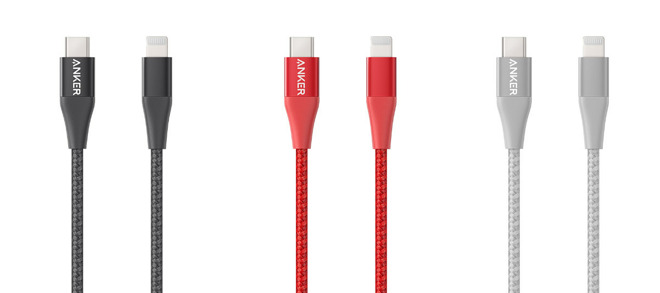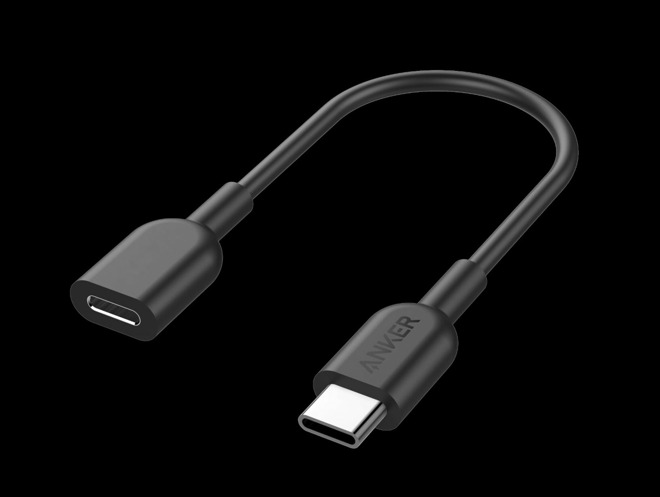Anker to debut USB-C to Lightning cables in March, audio adapter in April
Accessory juggernaut Anker on Monday previewed its first USB-C to Lightning cables, saying the accessories should ship out in March.

Anker shared the news of the new Powerline and Powerline+ USB-C to Lightning cables with AppleInsider just after CES, where other manufacturers such as Griffin and Belkin debuted their own products.
Anker's lineup is robust, if not iterative on existing Lightning cables already on the market.
The Powerline+ USB-C to Lightning has aluminum overmolds on each end and is reinforced with nylon throughout the length of the cable. The Powerline version of the cable uses aramid fiber in the cable itself for superior durability. Anker says the bend lifespan of the aramid version is five times higher than any other cable on the market, though those claims have gone untested.
Both cables can be purchased in 3t-foot and 6-foot lengths when they ship in March from Anker.com.

Anker USB-C to female Lightning
Anker is also releasing a USB-C to Lightning audio adapter in April. With the device, users can listen to Lightning EarPods or MFi-certified Lightning headphones on their Mac or iPad Pro via USB-C.

Anker shared the news of the new Powerline and Powerline+ USB-C to Lightning cables with AppleInsider just after CES, where other manufacturers such as Griffin and Belkin debuted their own products.
Anker's lineup is robust, if not iterative on existing Lightning cables already on the market.
The Powerline+ USB-C to Lightning has aluminum overmolds on each end and is reinforced with nylon throughout the length of the cable. The Powerline version of the cable uses aramid fiber in the cable itself for superior durability. Anker says the bend lifespan of the aramid version is five times higher than any other cable on the market, though those claims have gone untested.
Both cables can be purchased in 3t-foot and 6-foot lengths when they ship in March from Anker.com.

Anker USB-C to female Lightning
Anker is also releasing a USB-C to Lightning audio adapter in April. With the device, users can listen to Lightning EarPods or MFi-certified Lightning headphones on their Mac or iPad Pro via USB-C.

Comments
No doubt! Wireless is nice sometimes for convenience. If you want speed or stability, though, it sucks!
Yeah, though I'm not sure they are quite as good as Apple's, in my experience. But, super great for the price, and well designed (small jackets, connectors, etc.) When I come across a cable someone buys at the store, or that comes with a product, I'm often like... eww, how can you use a cable with such massive end/jacket-y things? And, it isn't just a aesthetic thing, the shorter it can be, the less leverage the cable puts in the ports. It scares me having a couple-inch long cable end-thing hanging off a tiny, delicate port! (And, maybe brings back bad memories of SCSI connectors with terminators and such hanging off file-server ports.)
That highlights another problem. There are all kinds of more speciality devices using these technologies. A great example are the FireWire audio units that cost $thousands and are still perfectly useable except for the FW port.
I got tired of coiling up the three-foot-long cable that came with my portable drive so I turned to Monoprice for a shorter one. It works fine and will probably last forever, but the damn thing is as stiff as a coat hanger! I don't know which is more hassle to work around on the desk -- a rat's nest of excess cable, or a cable so inflexible it dictates where the drive will sit instead of letting ME decide!
As an aside, I've stopped using active HDMI cables because of the limitation of only being able to use one in any particular chain. I mess around with connections often, in dark and hard to reach places, and create signal paths circuitous enough to cause confusion. I decided to preemptively head off the inevitable "Why doesn't this work?" by just removing active cables from my collection.
No problem. I just added a Firewire-to-Thunderbolt 2 adapter plugged into a Thunderbolt 2-to-Thunderbolt 3 adapter and went back to work! I just pretend that I don't have an almost foot-long garden hose sticking out the side of the computer, and that the combination of adapters didn't cost more than the video capture device they're connecting.
I totally agree about the inflexible cables, I hate those too.
Yeah, I'm glad that works and that those exist. My point, though, was that there are a lot of expensive peripherals that use a particular port, so it isn't always just easy for someone to 'move on' as we're being told by so many comments. And, even if adapters do exist, they are kind of a pain and certainly an inconvenience/eye-sore.
I don't want an all-wireless system, but neither do I want to cling to old protocols to protect my investment in old equipment. I can use adapters for the old stuff while taking advantage of the benefits a newer connection offers for everything else.
As an analogy, imagine your next car runs on a new fuel that gives you ten times the acceleration and ten times the range you get with gasoline. You can still run it on gas, but to do that you have to open the trunk and insert a three-foot long tube into the tank. That makes running the new car on gasoline more hassle than the car you have now, but in exchange you have the option to use the new super fuel with the speed and range advantages. Fair trade?
But, in context of this article and the question I was responding to... if one buys a new expensive device with Lightning port on it, and then Apple switches to USB-C, would it be fully supported? (Weren't there some 3.5mm based hardware devices that didn't work with the adapter after Apple dropped the jack? Like maybe those Square CC readers?) I can't remember if Lightning is just USB anyway, but I wonder if it is 100% comparability. Otherwise, you'd want to know before buying some Lightning based expensive add-on.
Except for the range part, it sounds a bit like a Tesla.
I understand why they might not want to use a cable with a C connector on the computer end yet, but there's no reason for it not to be C at the drive end. Even those who don't have USB-C equipped computers would still enjoy the benefit of a reversible connector on the drive. I just don't get why a manufacturer would deliberately choose not to include such an obvious improvement.
Tangent time: Writing the word "blade" reminded me that there's good value to be had on the portable SSD front at the moment. Amazon.ca has 1TB Crucial M.2 NVMe blades for CAD$179. A USB-C Gen2 enclosure for it was $49. That's $80 less than a Samsung T1 and four times as fast.
Wow, that's a pretty good deal. I'm getting the impression the price of all this SSD stuff is dropping fairly quickly. At some point, I'd like to add a few TB of external storage to my Mac mini setup and get rid of the spinning drive I sometimes have connected. Then I'll just use the spinning stuff for backup/archival.